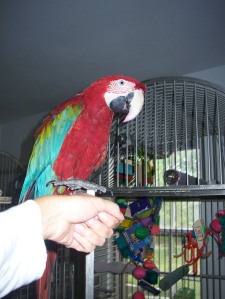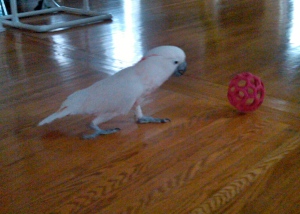
A cue is a sound or signal that elicits a behavior. Many times we give cues or signals to our birds when we want them to do something. For example, we may cue a bird to step up on our hand or fly to us by offering our hand. There also may be multiple cues such as saying the word “step up” or “come” accompanied by tapping the area of our hand where we want the bird to step up or fly to. See Video Below. In the world of domestic animals, the cue for a dog to sit may just be the word “sit”. Many times we have multiple cues and many times we need them. With cueing a dog to sit we may also point down and click our fingers while saying the word “sit”. All of these are cues for a particular behavior.
Cues are strong and numerous. Many undesired behaviors from the animals we work with may unknowingly be on cue. For example, the sound of approaching foot steps to a bird room could be putting a bird on cue to lunge when you walk by the cage. If with each time we pass the cage, that bird continues to lunge, we are reinforcing the bird’s behavior of lunging when we walk by. If a bird is on the floor and it chases feet whenever it sees feet, when we walk into the room, we could be cueing the bird to begin chasing our feet. So what is the solution? Put desired behaviors on cue. Putting desired behaviors on cue can be very effective if using the bird or animal’s positive reinforcers. Positive reinforcers are also known as rewards and it is always the bird or animal that decides what they are, never us. As long as we are working with a positive reinforcer that is more rewarding to the bird than the undesired behavior, we can make an alternative (desired) behavior more valuable to the bird. As I’ve stated, it is always the bird or animal that decides what the positive reinforcer or reward is. We, as caretakers or trainers can make those positive reinforcers more valuable to the bird by reserving their use for only during time of training.
For the bird that lunges with each time we walk by the cage, let the sound of our footsteps approaching the bird-room be a cue that something good is coming for the bird. For example, Molly my eclectus would lunge when I walked by the cage. She would hear my footsteps approaching and the sound of my footsteps was her cue to stand on the bowl-holder in her cage, which was closest to me when I would walk in. As I would approach her cage, she would rock back and forth quickly. Seeing my approach was her cue to go to that particular bowl holder. As I walked by she would lunge. So is it me walking by that cued the lunge? I wasn’t sure so I tried it again at a slow pace. She didn’t lunge. I tried it again at a normal pace and she lunged. What this told me was it wasn’t me walking by her cage that caused her to lunge, it was the pace at which I walked by her cage.
Immediately I began walking by her cage at a slower pace. I needed to begin pairing my approach with something of value to her. This had to be developed through repetition because my approaching footsteps are already a strong cue for an undesired behavior. I needed to re-train this. With each approach I slowed my pace of walking. As I walked by her cage she did not rock and did not lunge. As I began to pass her I would tell her “Good” and then positively reinforce or reward with a pine nut. From prior history I know Molly loves pine nuts so I made sure the pine nuts stayed of high value to her by not giving them to her at any other time other than training her to stay calm during my approach, my walking in front of her, and my passing her. Through consistent pairing of my approach now with the pine nuts, I began cueing a new behavior of calm. If there are not positive reinforcers or consequences for requested behaviors, why would the bird or other animal want give the behaviors when cued? If the animal is always positively reinforced after a requested behavior, the future rate of that behavior is very likely. If lunging while we walk by serves a purpose to the bird, why wouldn’t it continue? Find reinforcers of more value to the bird than lunging while we walk past, and deliver them to the bird when they give the desired behavior when cued. Make the pairing of the approach and walking past of more value to the bird than the lunge.
In this video you will see how I trained this. I edited out a few areas of long pauses in training to make it more interesting to the viewer. The first two times I walk by her cage, I walk by at a normal pace. She does not lunge like she does when the camera is not there, but you do see the quick rocking back and forth that is the cue to me that a lunge is very likely to happen. This, in addition to the lunge are both behaviors I want to see replaced by staying calm at my approach, during my passing, and after my passing of her cage. This video shows each consecutive approach and passing. I did not edit out any approaches or passing, they are all shown in order of how they happened. With each approach I slowly increase my pace. By the end of the video, I walk by two times at my normal pace. My approach has now been consistently paired with the delivery of the positive reinforcer. My approach is now her cue that she will receive a pine nut. The lunging no longer exists because the alternate behavior of staying calm is of more value to her.
With the bird who’s cue is to chase feet when he sees them on the floor, find an alternate behavior that is of more value to the bird. How? Pair it an alternate behavior with a consequence that is of high value to the bird. For example, I have a moluccan cockatoo that used to chase my feet as soon as it saw me come into the room. If I were to jump onto the countertop I could escape the consequence of the chase but the bird would still come over to see if I had jumped down. As soon as I jumped down, the bird would begin chasing me again. If the reason the bird was chasing my feet was to get me to leave the room, if I left the room I am reinforcing the future rate of the behavior of the bird chasing my feet. From a little history of interacting with this bird, I knew it liked to toss a ball. Before I would get the bird out of his cage and I knew the opportunity for this bird to chase feet was likely, I would make sure I had a ball within easy reach for me. There were cues to me that the bird was going to start chasing my feet. First cue was he would stand completely still and watch me with his crest up. I could see him look down at my feet. He would then look up at my eyes. Then he would take off running toward me whistling with his crest up. The chase was on.

Here is where the training started. When I saw the two cues, standing still, then the body scan, before he could start running I would grab the ball and toss it in the air. This caused him to focus on the ball and not on my feet. I would then put the behavior of him interacting with the ball on cue by pairing the words “Get the ball, Rocky” with me tossing the ball. As this continued to happen with each time I walked in the room, I began looking for the cue of him standing still. I would toss the ball before he even gave me the cue of the body scan. Through consistency of pairing my walking in the room with him standing still and my tossing the ball in the air, Rocky began chasing the ball more. Me walking in the room was now his cue for the ball toss game getting ready to begin. In the beginning, I needed to pair my walking in the room with the ball-toss game every single time until I knew Rocky clearly understood that me walking in the room was his cue for the ball-tossing game to begin. I had to be very careful to not let the chase begin because if I let it happen once in a while, this puts his behavior of chasing on an intermittent schedule of reinforcement. What I mean by this is that the behavior of him chasing my feet would be reinforced once in a while. Having a behavior (desired or undesired) reinforced once in a while helps keep that behavior very, very strong. If I were to walk in and see that he was cueing me the chase was going to start and I didn’t think I could cue him to do something else, I would walk back out before he could start chasing while I thought of what else I could do. I definitely did not want to let that chase begin because I would intermittently reinforce it. I would find other things for him to play toss with and then positively reinforce him playing toss. Sometimes his positive reinforcers for tossing the ball were to hear the tone of voice I give when excited. Sometimes my clapping my hands in excitement were his reinforcers for tossing the ball. I often sat on the floor with him while tossing the ball. Soon he tired. Soon he would be calmly perching on my leg while I petted him.
So many behaviors. So many cues. If we see an animal reacting consistently to our approach, we are cueing that animal to act that way. If a bird begins screaming when they hear our car pull in the driveway, that behavior is being cued. Cueing desired behaviors helps take stress and anxiety out of our parrot’s environments. Many undesired repetitive behaviors such as rhythmic screaming, rocking, and feather picking can be consequences of having stress and anxiety in their environment. Training and reinforcing alternate behaviors is one way to help eliminate that stress and anxiety.
Leave a Reply